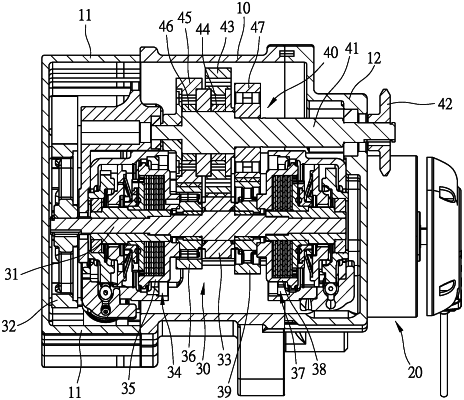| CPC F16H 3/10 (2013.01) [F16H 2200/0039 (2013.01)] | 3 Claims |

|
1. A three-stage speed-change mechanism, comprising:
a drive assembly, which comprises an electrical motor, the electrical motor having an output shaft that comprises a drive wheel that drives an input assembly;
the input assembly, which comprises a transmission shaft driven by the drive wheel, an initial transmission wheel being mounted on a middle section of the transmission shaft, a first speed-change assembly and a second speed-change assembly being respectively arranged at two opposite sides of the initial transmission wheel, wherein the first speed-change assembly comprises a first clutch arranged on the transmission shaft, the first clutch being provided with a first transmission wheel that is arranged on the transmission shaft and is selectively drivable; and the second speed-change assembly arranged on the opposite side comprises a second clutch arranged on the transmission shaft, the second clutch being provided with a second transmission wheel that is arranged on the transmission shaft and is selectively drivable; and
an output assembly, which comprises an output shaft that is arranged parallel with an axis of the transmission shaft of the input assembly, the output shaft being provided, on a middle section thereof, with an initial driven wheel in mating engagement with the initial transmission wheel, a first speed-change wheel and a second speed-change wheel being respectively arranged on two opposite sides of the initial driven wheel, wherein the first speed-change wheel is in mating engagement with the first transmission wheel, and the second speed-change wheel is in mating engagement with the second transmission wheel, and the initial driven wheel is mounted by means of a first one-way bearing on the output shaft, and the first speed-change wheel is mounted by means of a second one-way bearing on the output shaft, wherein the first one-way bearing and the second one-way bearing are one-way elements that are lockable for driving in a same direction, and a rotational speed generated by means of a gear ratio between the first transmission wheel of the first speed-change assembly and the first speed-change wheel is higher than a rotational speed generated by means of a gear ratio between the initial transmission wheel and the initial driven wheel, and a rotational speed generated by means of a gear ratio between the second transmission wheel of the second speed-change assembly and the second speed-change wheel is higher than the rotational speed generated by means of the gear ratio between the initial transmission wheel and the initial driven wheel;
wherein in the input assembly, the initial transmission wheel is directly mounted to the transmission shaft of the input assembly, and in the output assembly, the second speed-change wheel is directly mounted to the output shaft; and
wherein the drive assembly, the input assembly, and the output assembly are arranged in an interior of a casing, and a first end cover and a second end cover that are selectively removable are respectively mounted to two ends of the casing to respectively correspond to the first speed-change assembly and the second speed-change assembly;
wherein an end of the transmission shaft of the input assembly is provided with a driven wheel fixedly mounted thereto to be driven by the drive wheel; and
wherein the drive wheel of the drive assembly is set in mating and transmitting engagement with the driven wheel of the input assembly by means of a gear ratio adjusting assembly, and the gear ratio adjusting assembly comprises a first gear and a second gear that are coaxial and are rotatable in synchronization with each other, wherein the first gear is in mating engagement with the drive wheel, and the second gear is in mating engagement with the driven wheel, so that an initial rotational speed that the drive assembly drives the input assembly is variable by varying a gear ratio of the first and second gears.
|